4 essential tips to reducing heat stress in Texas longhorn cattle in Texas
by Cathy Valle
Since Ancient Roman times the Dog Days of Summer, generally the period between July 3 and Aug 11, have been referred to as the hottest time of the year in the northern hemisphere. In case you are wondering about the origin of the phrase, Sirius, the ‘dog star’ and brightest star in the sky is closest to the sun at this time. But, never mind dogs, what does this mean for our cattle?
Luckily, Texas longhorn cattle can generally manage extreme temperatures. Having said that, these past few weeks in Texas have been intense to say the least, with too many triple digit figures and no respite in sight.
Dr. Ron Gill of Texas A&M AgriLife Extension points out that heat tolerant cattle breeds can still suffer from the extreme Texas heat. With that in mind, here are precautions ranchers can take for the wellbeing of Texas longhorn cattle and for other less tolerant cattle breeds.
Four tips to reduce heat stress in your Texas longhorn cattle
1. Texas longhorn cattle require SHADE
If you don’t have man made shelters, don’t worry too much. Trees are great at offering relief from the hot Texas sun. So much so, in fact, that on a very hot day our shelters are often empty.
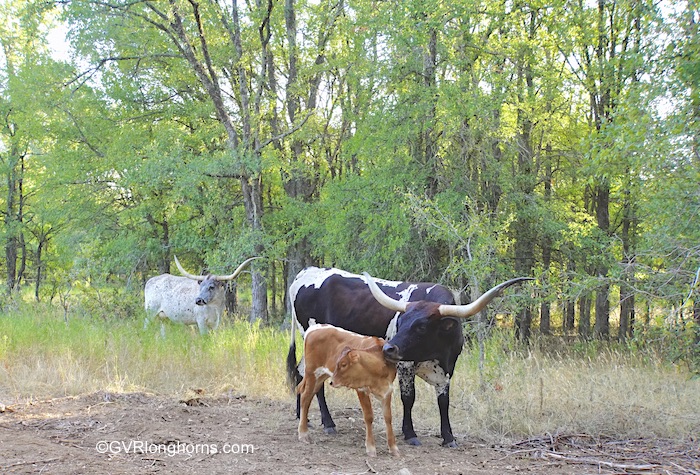
Our Texas longhorn cattle readily favor the natural shade of the trees. In fact, the USDA suggests that natural shade from trees is often preferred by cattle over artificial shade structures. Trees block direct sunlight and also help in blocking reflected sun rays.
Fortunately at Green Valley Ranch, we have a lot of trees which is a good thing on hot summer days because evenly distributed shade encourages cattle to spread out. 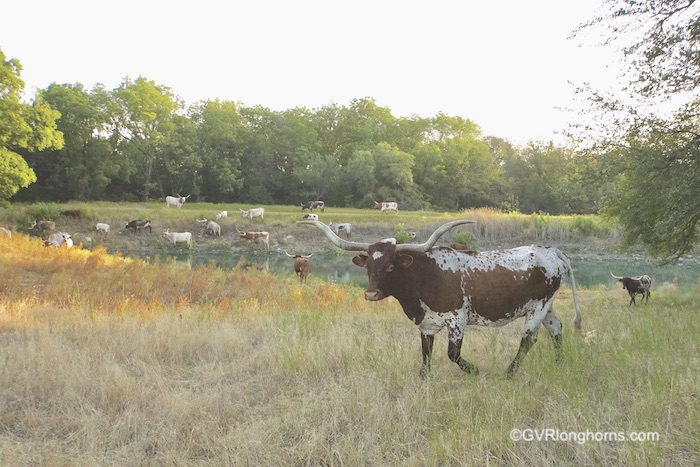
After all, overusing one area can ultimately lead to contaminating that area and logic suggests that kinda defeats the purpose.
2. WATER is a requirement – ALWAYS
Texas longhorn cattle require water daily to survive. So much so, we have plunged into the subject on many occasions and flooded our blog with information.
Here are a few examples,
- Is water accessible to your longhorns year round? (July 1, 2021, tip number 5)
- 7 Points to PONDer when building a Stock Tank. (April 1, 2019)
- How to ensure your Texas Longhorn Cattle have water all year round. (April 2, 2021)
the above articles can be found on our blog – click here
Not intending on drowning you (sorry!) with the subject but it’s essential to ensure that a water source is readily available to keep Texas longhorn cattle hydrated and cool.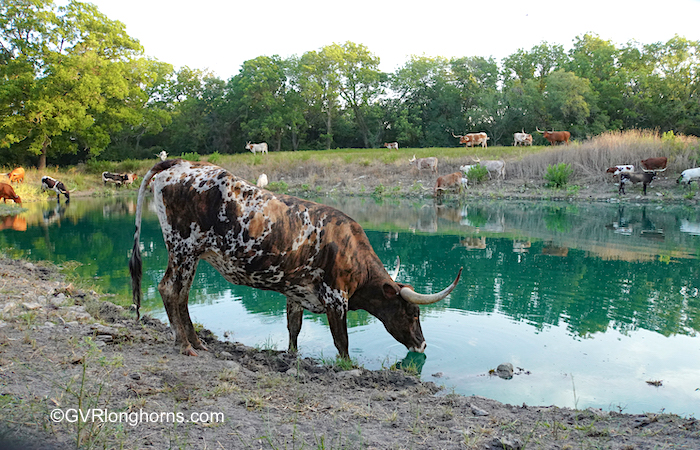
Cattle will usually drink about 5- 8 gallons of water a day. Their water intake will vary depending on the water content of their forage. However, across the board, a cow’s water requirements could double and even triple when temperatures go up.
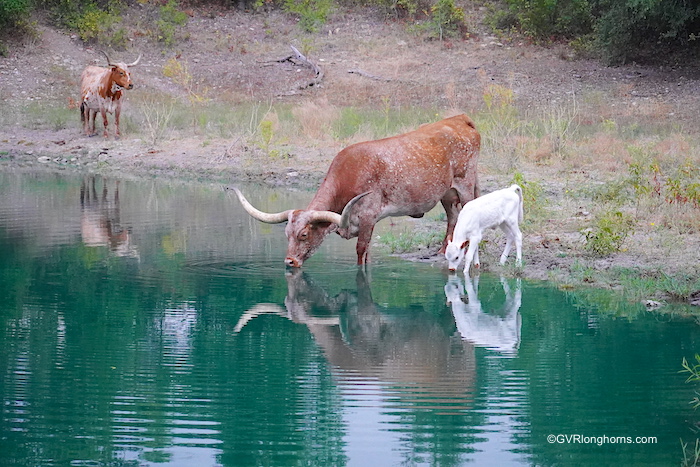
Dr. Gill emphasizes the importance of good clean water and reminds ranchers that cattle are likely to get into water if they have access to it and in so doing increase the possibly of them polluting the water they drink.
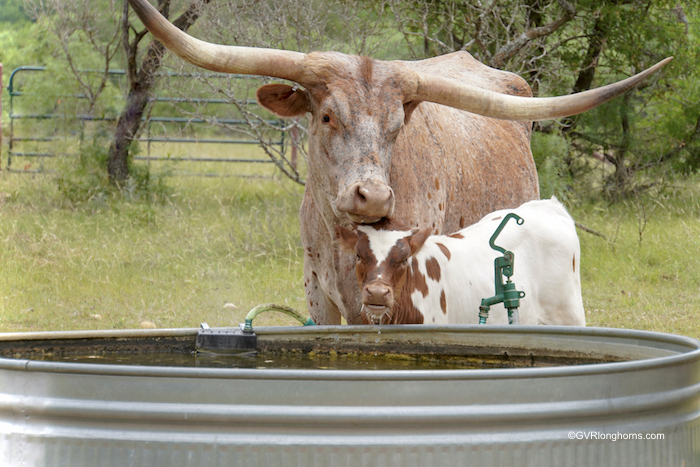
3. Cattle eat less when it’s hot outside and here’s why…..
According to Dr. Thomas Welsh of Texas A&M University Department of Animal Science, a cow’s metabolism effects her body temperature. For example, fermentation in the rumen produces heat. In other words, when a cow ruminates, she is in fact producing heat.
To help cattle regulate their body temperature on hot days, Welsh points to research which suggests feeding higher quality forage. His recommendation is based on the premise that the fermentation process of high quality forage generates less heat during digestion than low quality forage does.
So, even though we keep our stocking rates per acre low and our carrying capacity is substantially higher, we make sure to put out hay in summer during a heat wave such as we are experiencing this year. We also keep minerals replenished.
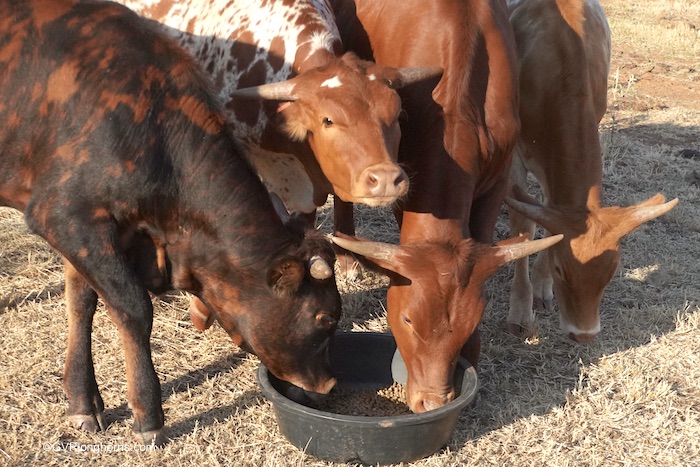
4. Longer periods of REST – even for Texas longhorn cattle
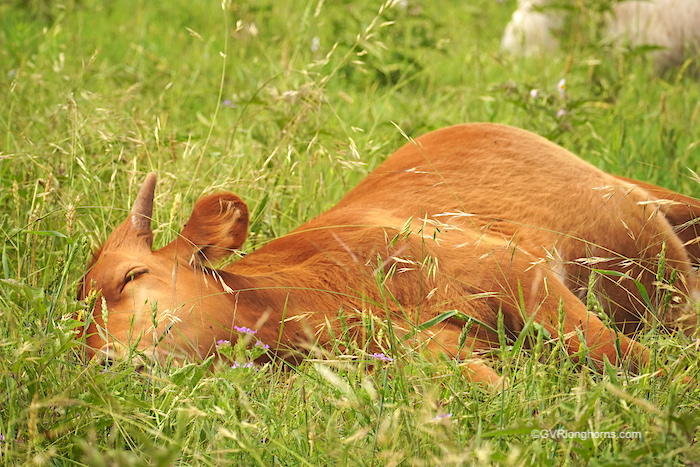
- Plan ahead, avoid working cattle!
Or, at the very least work cattle early in the morning. Working cattle and exerting them unduly, causes stress. We have noticed that our cattle love routine and changing their routine in itself causes stress. Amanda Radke, writing for the BEEF Magazine emphasizes that anything one can do to minimize stress is important.
For example:-
Work smaller groups to allow them more space.
Move cattle slower to prevent them over exerting themselves.
Reduce standing time in the chute to reduce overall stress.

For details on Sweetpepper and our other longhorns for sale click HERE
IN CONCLUSION
It has been well documented that typically, Texas longhorn cattle manage extreme temperatures. Nonetheless, in an article titled, “Recognizing and Avoiding Heat Stress in Cattle”, posted on from the Department of Animal Sciences Texas A & M University, it is emphasized that cattle are more susceptible to heat stress in higher temperatures where there is also high humidity.
With that in mind checking the weather forecast ahead of time is a good idea before handling cattle, even Texas longhorn cattle in Texas. Ensuring shade and water is always necessary and rescheduling activities like weaning, branding and even moving healthy cattle may well be worthwhile in sweltering heat. However, if working or moving cattle in hot and humid weather is unavoidable, the same article cautions that if “they [cattle] begin to experience any signs of severe heat stress—such as rapid breathing or open-mouth panting—release them and call a veterinarian for assistance.”

Reference articles:-
https://www.beefmagazine.com/management/triple-digit-temperatures-mean-watching-cattle-heat-stress
https://www.beefmagazine.com/cow-calf/5-tips-keep-your-cattle-safe-summer-heat
Texas A & M Department of Animal Science publications
Recognizing and avoiding heat stress in cattle
Disclaimer: All material noted above is based on our hands- on experience as ranchers, as well as our observations of our own cattle over the years. We have done and continue to do extensive research in order to maintain our herd‘s optimum health. However, all opinions and statements made on our website are guidelines only. We are not qualified statisticians/ veterinarians and urge you to consult a specialist with your concerns. GVR Longhorn LLC owns all content of this blog and all pictures. In other words, NO copying please! ©GVRlonghorns.com All rights reserved
Please let us know how you feel about this post in the comments below or email us directly and if you enjoyed reading it please consider sharing it.
We love hearing from you.
Thank you for spending time with us,
Cathy


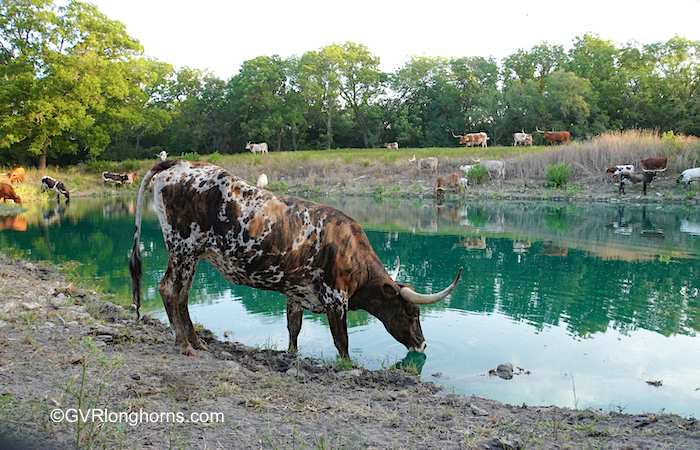
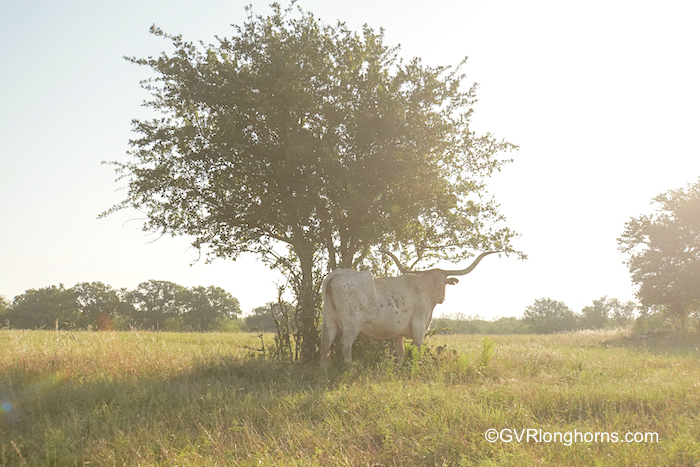
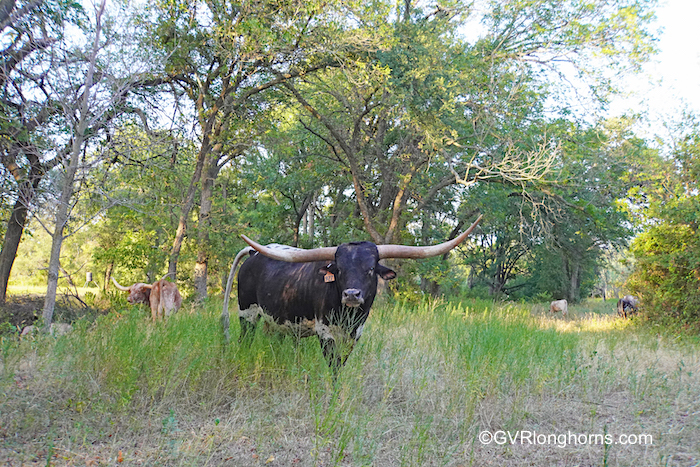
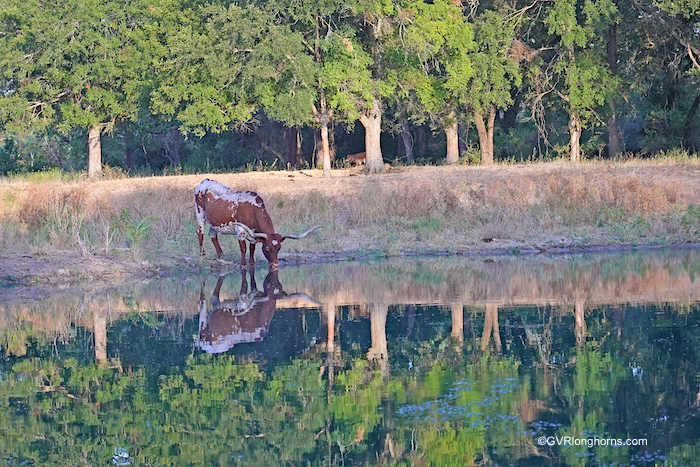
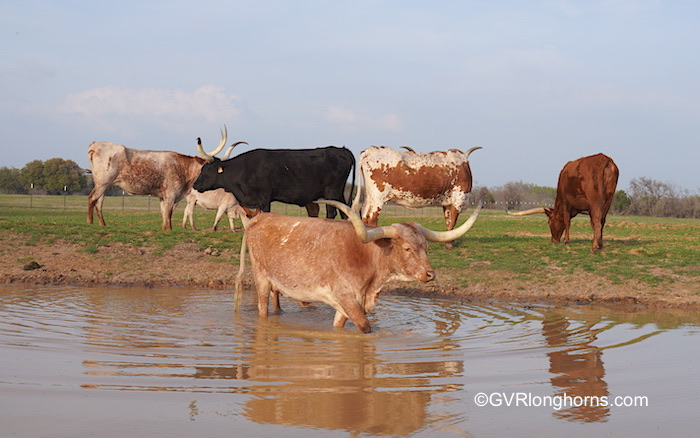
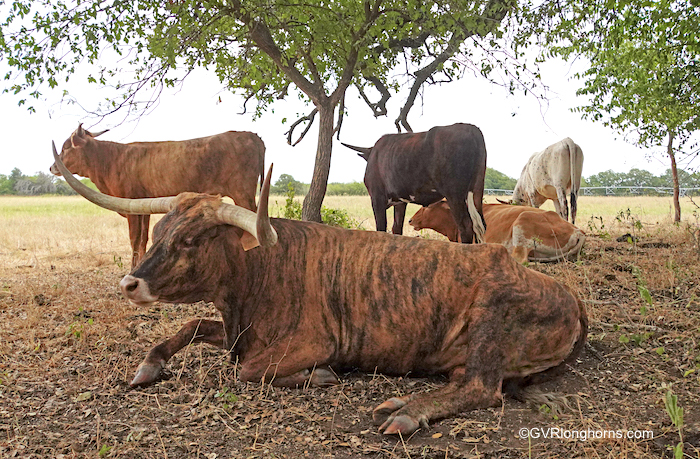
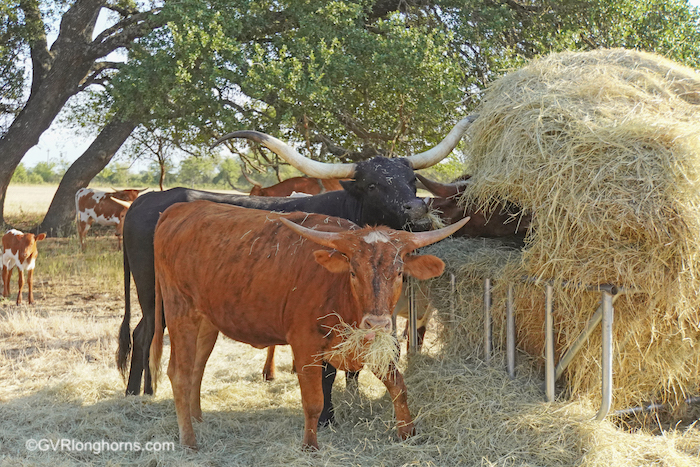
Great cattle, beautiful and healthy! I,ve had Scotch Highlands for years,but if I still had my farm I would have some longhorns. Nice work!
Thank you so much. We appreciate your support and encouragement.